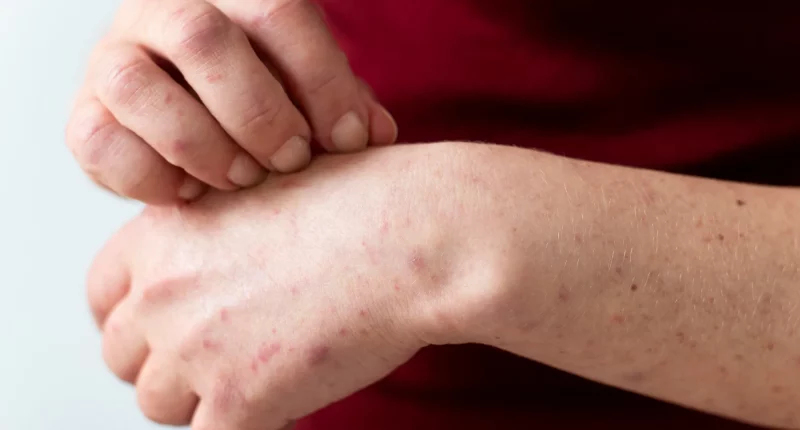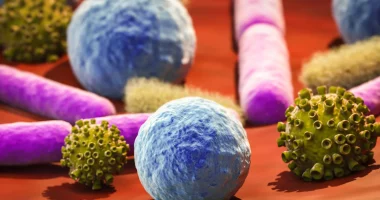Candidiasis, also known as a yeast infection, is caused by a type of fungus termed Candida. This fungus is normally present in small amounts on your skin and in areas like your mouth, throat, vagina, and intestines.
The most common type of Candida is Candida albicans or C. albicans. Although this is the most frequently encountered, there are many different kinds of Candida. This fungus thrives in warm, moist environments, making it easier for infections to develop in such conditions.
C. albicans infections are quite common and are generally straightforward to diagnose and treat. However, some infections and certain strains of Candida can be more serious and might pose significant health risks. If you suspect you have a Candida infection, it’s important to get it checked by a healthcare professional to ensure proper treatment.
Types and Symptoms of Candidiasis
Candidiasis can affect various areas of the body, and its name changes depending on the location of the infection. When Candida affects the genitals, it is known as vaginal yeast infection or vaginal candidiasis in women, and candidal balanitis in men. Infections in the mouth are called oropharyngeal candidiasis or thrush. When Candida infects the diaper area, it is referred to as a yeast diaper rash. On the skin, it is known as cutaneous candidiasis, and when it affects the fingernails or toenails, it is called candidal paronychia. In more severe cases, when Candida enters the blood or internal organs, it is termed invasive candidiasis.
Male Yeast or Vaginal Infection
Vaginal candidiasis, also known as a vaginal yeast infection, occurs when there is an overgrowth of Candida, particularly C. albicans, in the vagina. It is a common issue, affecting around 30 percent to 50 percent of women at some point in their lives, with increased frequency during pregnancy. Yeast infections are also often triggered by the use of antibiotics. Symptoms include vaginal soreness or itching, pain during sexual practice, redness discomfort while urinating, and abnormal discharge.
Men can also experience genital yeast infections, though it is less common and often asymptomatic. When symptoms do appear, they typically involve inflammation of the end of the penis and may include rashes, foul-smelling discharge, and pain.
Thrush
Thrush occurs in the mouth, throat, or esophagus and is particularly common among babies, individuals with diabetes, and those with HIV. Symptoms of thrush involve white patches on the roof of the mouth, tongue, and internal side of the cheeks, redness, soreness, discomfort while eating or swallowing, and cracks in the mouth cracks. For breastfeeding mothers, thrush in their baby can cause painful and cracked nipples.
Cutaneous Candidiasis
Cutaneous candidiasis affects the skin, typically in warm and moist areas like the groin, anus, armpits, and under the breasts. It causes a rash with skin breakdown and redness, oozing patches, pimples, and burning or itching sensations.
Yeast Diaper Rash
A yeast diaper rash may develop in babies, either alone or alongside thrush. It is characterized by a raised border, smaller red patches blending with larger ones, ulcers, blisters, or pus-contained sores, and scaly or red areas on the genitalia. This type of rash is confined to the area under the diaper and often does not respond to typical diaper rash treatments. If the rash persists despite treatment, it could be indicative of candidiasis.
Fingernail and Toenail Infections
Candidal infections of the nails often happen in individuals who frequently expose their hands or feet to water, or those who have pedicures or manicures with contaminated tools. Symptoms include painful swelling and redness around the nail, which may be accompanied by pus and, in severe cases, nail discoloration.
Invasive Candidiasis
Invasive candidiasis is a more severe form of Candida infection that affects internal organs and is less common. It typically happens in individuals who are already critically ill, like those with organ transplants or in intensive care. This form of candidiasis can be life-threatening and often affects the blood (candidemia), heart, eyes, brain, and bones. Symptoms generally include fever and chills that do not react to antibiotics, with other symptoms varying based on the infected organs.
Causes
Candidiasis typically arises when the Candida fungus, which is normally present in small amounts on the body, begins to overgrow. This overgrowth often occurs when certain conditions disrupt the balance of the fungus. For instance, using antibiotics for a bacterial infection, like pneumonia or urinary tract infection, can kill beneficial bacteria that usually keep Candida in check, leading to an overgrowth. Additionally, a weakened immune system, whether due to diseases like HIV or as a side effect of medications such as steroids or chemotherapy, can make it easier for Candida to proliferate.
Several other factors can increase the risk of developing candidiasis. These include pregnancy, which can alter the body’s environment, and the use of hormonal contraceptives like birth control pills. Diabetes is another significant risk factor, as it can create an environment conducive to Candida growth. Poor hygiene, wearing tight-fitting underwear or wet clothing, and being overweight can also contribute to candidiasis.
Environmental factors, such as hot and humid conditions, can further promote fungal growth. Using skin products that irritate the skin, being uncircumcised, and using spermicides or condoms with lubricants can also increase susceptibility. Cancer treatments, such as chemotherapy, and sexual activity may also play a role. Additionally, perfumed products used in the vaginal area, douching, and very hot baths or hot tubs can disrupt the natural balance and create favorable conditions for Candida overgrowth.
Diagnosis
Diagnosing candidiasis depends on where the infection is located, but there are some common methods used across different types of infections.
For most yeast infections, except for invasive candidiasis, the process usually begins with a physical examination of the affected area by a healthcare provider. To confirm the diagnosis, they might take a swab or scrape from the infected site. This sample is then sent to a laboratory, where it is examined under a microscope to identify the presence of Candida.
For vaginal yeast infections, there are home tests available that measure the pH level of vaginal secretions. However, these tests are not as reliable as those performed by a healthcare provider because they do not specifically test for Candida. Therefore, a healthcare provider’s test is generally more accurate.
In the case of invasive candidiasis, which is a more severe and systemic form of the infection, a blood sample is collected and sent to a lab for culturing. This means that the lab will try to grow the Candida fungus from the blood sample to confirm the presence of the infection.
Additionally, your doctor might order other tests to check if candidiasis is linked to an underlying health condition, like diabetes, which could be contributing to the infection.
Treatment
Treating candidiasis typically involves using antifungal medications, which can be either available over the counter or recommended by a healthcare provider. The kind of medication used is generally the same regardless of where the infection is located, but how strong the medication is and how it is applied can differ.
Common antifungal treatments include:
- Lotrimin and Mycelex (both containing clotrimazole)
- Monistat (which contains tioconazole)
- Micatin (which contains miconazole)
- Nystatin (also known as Mycostatin)
These medications come in different forms, like creams, ointments, or suppositories, depending on the area affected.
In addition to using medication, it’s important to keep the infected area clean and dry. Moist environments can help Candida thrive, so maintaining good hygiene and keeping the area as dry as possible can aid in clearing up the infection.
Summary
Candidiasis, commonly known as a yeast infection, is caused by the fungus Candida, which overgrows under certain conditions. The infection can occur in various body parts, including the genitals, mouth, skin, and nails. Diagnosis typically involves a physical exam and lab tests, such as swabs or blood cultures.
Treatment usually includes antifungal medications like clotrimazole or miconazole, available over-the-counter or by prescription. Keeping the infected area clean and dry is also important for effective treatment. For invasive candidiasis, additional tests may be needed to check for underlying health issues.









